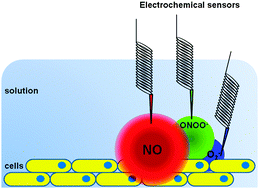Designing molecular materials and strategies for the electrochemical detection of nitric oxide, superoxide and peroxynitrite in biological systems
Abstract
We present an overview of the successes and challenges still faced in the

- This article is part of the themed collection: Bioelectrochemistry

 Please wait while we load your content...
Please wait while we load your content...